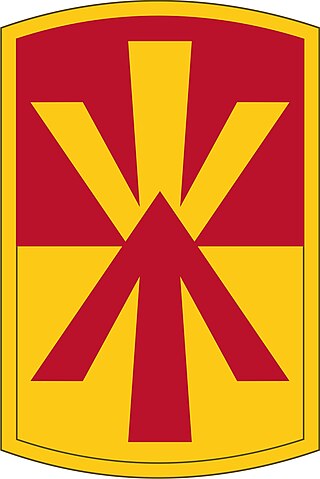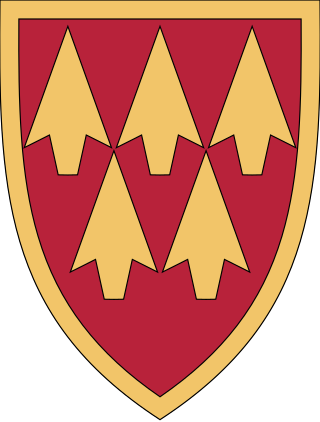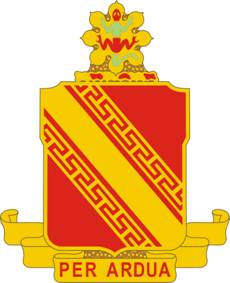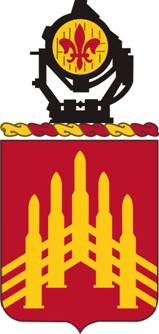The 60th Air Defense Artillery Regiment is an air defense unit of the United States Army.

The 108th Air Defense Artillery Brigade is an air defense artillery brigade of the United States Army. The mission of the brigade is to train and maintain a strategic crisis response air defense artillery brigade capable of deploying worldwide, on short notice, to provide air defense force protection from air-breathing threats and tactical ballistic missiles, as well as allow freedom of maneuver for XVIII Airborne Corps operations.

The 4th Air Defense Artillery Regiment was constituted 1 June 1821 in the Regular Army as the 4th Regiment of Artillery and organized from new and existing units with headquarters at Pensacola, Florida. As a result of the division of the Artillery Corps into Coast and Field Artillery units, the Regiment was broken up 13 February 1901, and its elements reorganized and redesignated as separate numbered companies and batteries of the Artillery Corps.

The 11th Air Defense Artillery Brigade is an air defense artillery brigade of the United States Army stationed at Fort Bliss.

The 32nd AAMDC or 32nd Army Air and Missile Defense Command is a theater level Army air and missile defense multi-component organization with a worldwide, 72-hour deployment mission. The 32nd AAMDC commands echelon above corps (EAC) ADA brigades and other assigned forces. Four such brigades, 11th Air Defense Artillery Brigade, 31st Air Defense Artillery Brigade, 69th Air Defense Artillery Brigade, and 108th Air Defense Artillery Brigade; by training, all stand ready to accomplish their mission of air defense against missile attack – 'anywhere, anytime' in support of the war-fighting combatant commander (CCDR).

The 38th Air Defense Artillery Brigade is an active United States Army unit which provides air and missile defense to critical assets in the Pacific theater. Since 2018 the brigade headquarter is based at Sagami General Depot in Japan.

The 52nd Air Defense Artillery Regiment is an air defense artillery regiment of the United States Army first organized in 1917 as a railway gun unit. It continued in that role unit 1943, when the regiment was broken in separate railway gun battalions, and in the following year the units were reorganized and redesignated as field artillery.

The 2nd Air Defense Artillery Regiment is an air defense artillery regiment of the United States Army, first formed in 1821 as a field artillery unit.

The U.S. Army Coast Artillery Corps (CAC) was an administrative corps responsible for coastal, harbor, and anti-aircraft defense of the United States and its possessions between 1901 and 1950. The CAC also operated heavy and railway artillery during World War I.

The 7th Air Defense Artillery Regiment is an air defense artillery regiment of the United States Army, first constituted in the Regular Army as the 7th Regiment of Artillery on 8 March 1898. The 6th and 7th U.S. Artillery Regiments were constituted on 8 March 1898, three weeks after the explosion of USS Maine in Havana, Cuba on 15 February 1898, as the United States' declaration of war on Spain and commencement of the Spanish–American War seemed imminent.

The 32nd Field Artillery Regiment is a distinguished and highly decorated field artillery regiment of the United States Army, first Constituted in 1918.

The 43rd Air Defense Artillery Regiment is an air defense artillery regiment of the United States Army first constituted 1918 in the Regular Army.

The 44th Air Defense Artillery Regiment is an Air Defense Artillery regiment of the United States Army, first constituted in 1918 in the Regular Army during World War I. During World War II the unit served as the 54th Coast Artillery Regiment

The 6th Air Defense Artillery Regiment is an air defense artillery regiment in the United States Army, first formed in 1898 as the 6th Regiment of Artillery. The 6th and 7th U.S. Artillery Regiments were constituted on 8 March 1898, three weeks after the explosion of the USS Maine in Havana, Cuba on 15 February 1898, as the United States' declaration of war on Spain and commencement of the Spanish–American War seemed imminent.

The 56th Air Defense Artillery is a training regiment in the United States Army.

The 71st Air Defense Artillery was a regiment in the United States Army.
The 62nd Air Defense Artillery Regiment is an Air Defense Artillery regiment in the United States Army. The lineages of some of the units that have been part of the 62nd Air Defense Artillery and its predecessors give the regiment campaign credit for the War of 1812.
The 202nd Air Defense Artillery was an antiaircraft regiment of the Illinois Army National Guard.
The 251st Coast Artillery was a coast artillery regiment in the California National Guard, constituted in 1924 as a harbor defense regiment for the 9th Artillery District and re-designated in 1930 as an antiaircraft regiment. It served in World War II in that capacity.
The 562nd Air Defense Artillery Regiment was an air defense regiment of the United States Army. It was organized under the Combat Arms Regimental System.


 4th Battalion, 5th Air Defense Artillery Regiment,
4th Battalion, 5th Air Defense Artillery Regiment, 1st Battalion, 44th Air Defense Artillery Regiment, [2]
1st Battalion, 44th Air Defense Artillery Regiment, [2]  1st Battalion, 62nd Air Defense Artillery Regiment. [3]
1st Battalion, 62nd Air Defense Artillery Regiment. [3] 















